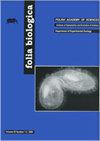全球气候变化下槭木蚜虫的分布
IF 0.8
4区 生物学
Q4 BIOLOGY
引用次数: 1
摘要
Drepanaphis del Guercio属目前包括16种,全部在北美发现。本属的代表是主要与槭属植物有关的窄寡噬体。以往的研究只关注特定物种的形态,而没有考虑它们的地理分布。在所有种类中,漆枫蚜虫(Drepanaphis acerifoliae)值得特别注意,因为它代表了北美最广泛的分布范围,并且是该属唯一在其自然分布范围之外发现的物种,即在欧洲。利用最大熵模型建立合适的生态位模型,绘制出了针叶松在其自然分布范围内的潜在分布图。在北美,它的分布与寄主植物的自然范围(原产于东部)以及种植它们的地区(西部)一致。将这些结果外推到欧洲地区,可以指定蚜虫可以找到适合发展和扩大其空间分布的气候条件的地方。该模型显示了地中海盆地、意大利几乎全部(不包括山区)、西班牙、葡萄牙、法国、比利时、荷兰、德国西部、英国东南部和中部、匈牙利和巴尔干半岛。从更广阔的大陆视角来看,该模型指向了从包括克里米亚在内的乌克兰东部中部,穿过俄罗斯,到哈萨克斯坦北部与俄罗斯接壤的地区。此外,还分析了未来80年气候变化对该物种在北美和欧洲传播的影响。考虑到潜在的未来气候变化的模型表明,针叶草可能会在其目前分布范围的更北的地方找到合适的生态位。在北美,这主要是加拿大东部地区,而在欧洲,它包括俄罗斯的中东部和亚洲部分。本文章由计算机程序翻译,如有差异,请以英文原文为准。
Distribution of Drepanaphis acerifoliae – aphid pest of Acer trees – faced with global climate change
The genus Drepanaphis del Guercio currently includes 16 species, all of which are found in North America. Representatives of this genus are narrow oligophages associated mainly with plants of the genus Acer. Previous studies have focused only on the morphology of selected species, while not considering their geographical distribution. Among all species, the painted maple aphid Drepanaphis acerifoliae deserves particular attention, because it represents the broadest range in North America and is the only species of this genus to be found outside of its natural range, i.e. in Europe. Thanks to suitable niche modelling based on a maximum entropy model, we were able to present maps with the potential distribution of D.acerifoliae in its natural range. In North America, its distribution coincides with the natural range of the host plants (native to the eastern part), as well as the areas where they are planted (the western part). An extrapolation of these results to the area of Europe allowed for the designation of places where the aphids can find suitable climatic conditions for developing and expanding their spatial distribution. The model indicated the Mediterranean basin, almost all of Italy, excluding mountainous areas, Spain, Portugal, France, Belgium, the Netherlands, the western part of Germany, the southeast and central part of Great Britain, Hungary and the Balkan Peninsula. In a more continental view, the model pointed to areas stretching from the middle of eastern Ukraine, including Crimea, through Russia, to northern parts of Kazakhstan along the border with Russia. Additionally, the impact of climate change on the spread of the species within the next 80 years was analysed, both in North America and Europe. Models considering the potential future climate changes indicate that D.acerifoliae may find suitable niches further north of its current ranges. In North America, this is mostly areas of eastern Canada, while in Europe it includes the central and eastern part and the Asian part of Russia.
求助全文
通过发布文献求助,成功后即可免费获取论文全文。
去求助
来源期刊

Folia Biologica-Krakow
医学-生物学
CiteScore
1.10
自引率
14.30%
发文量
15
审稿时长
>12 weeks
期刊介绍:
Folia Biologica (Kraków) is an international online open access journal accepting original scientific articles on various aspects of zoology: phylogeny, genetics, chromosomal studies, ecology, biogeography, experimental zoology and ultrastructural studies. The language of publication is English, articles are assembled in four issues per year.
 求助内容:
求助内容: 应助结果提醒方式:
应助结果提醒方式:


